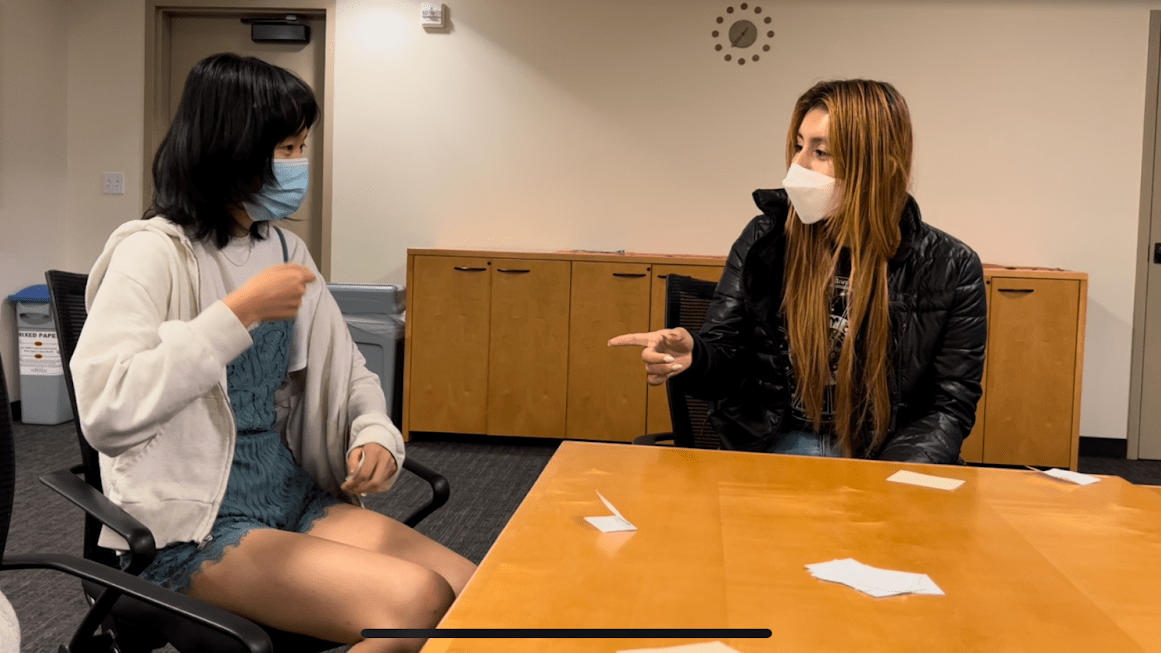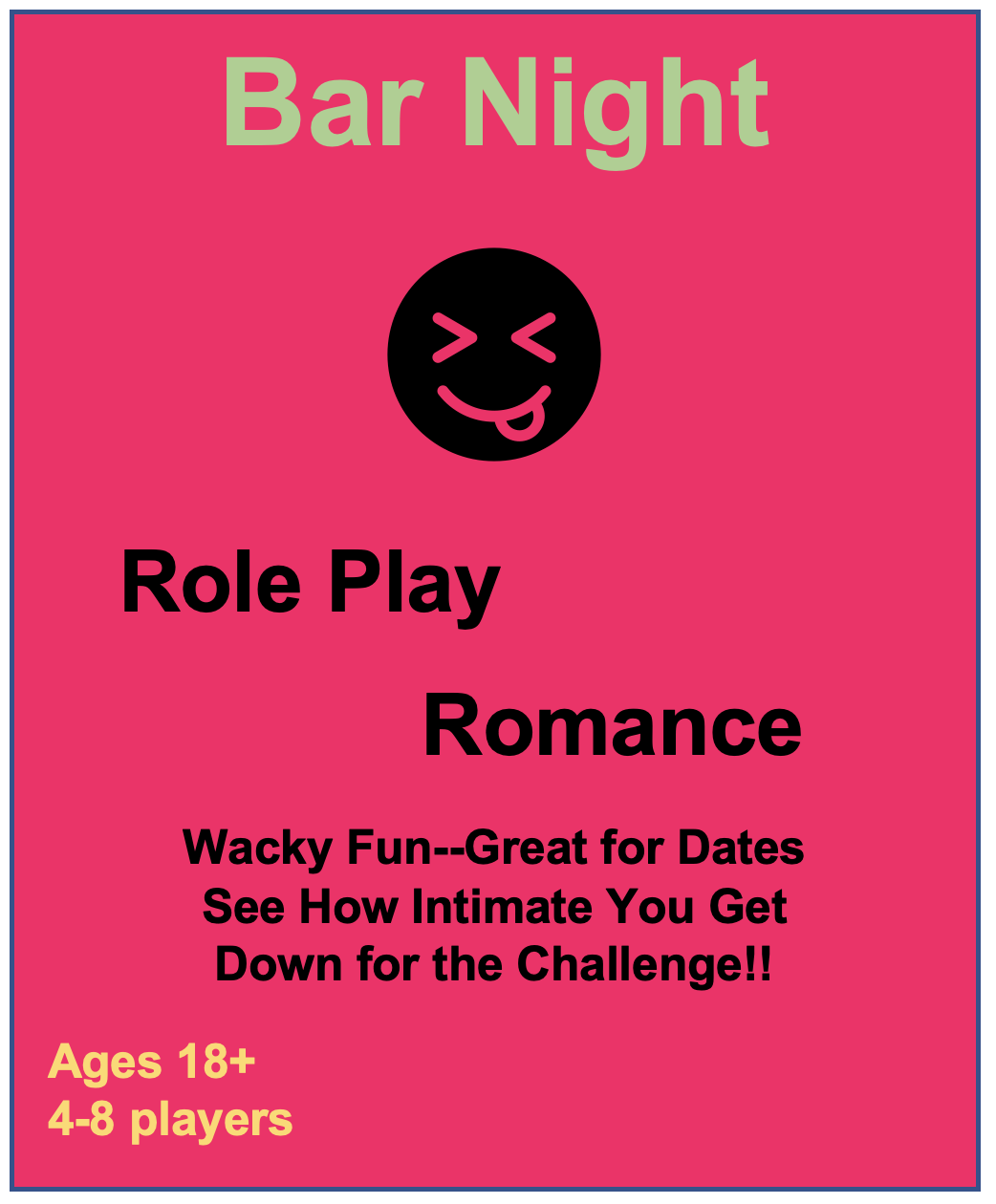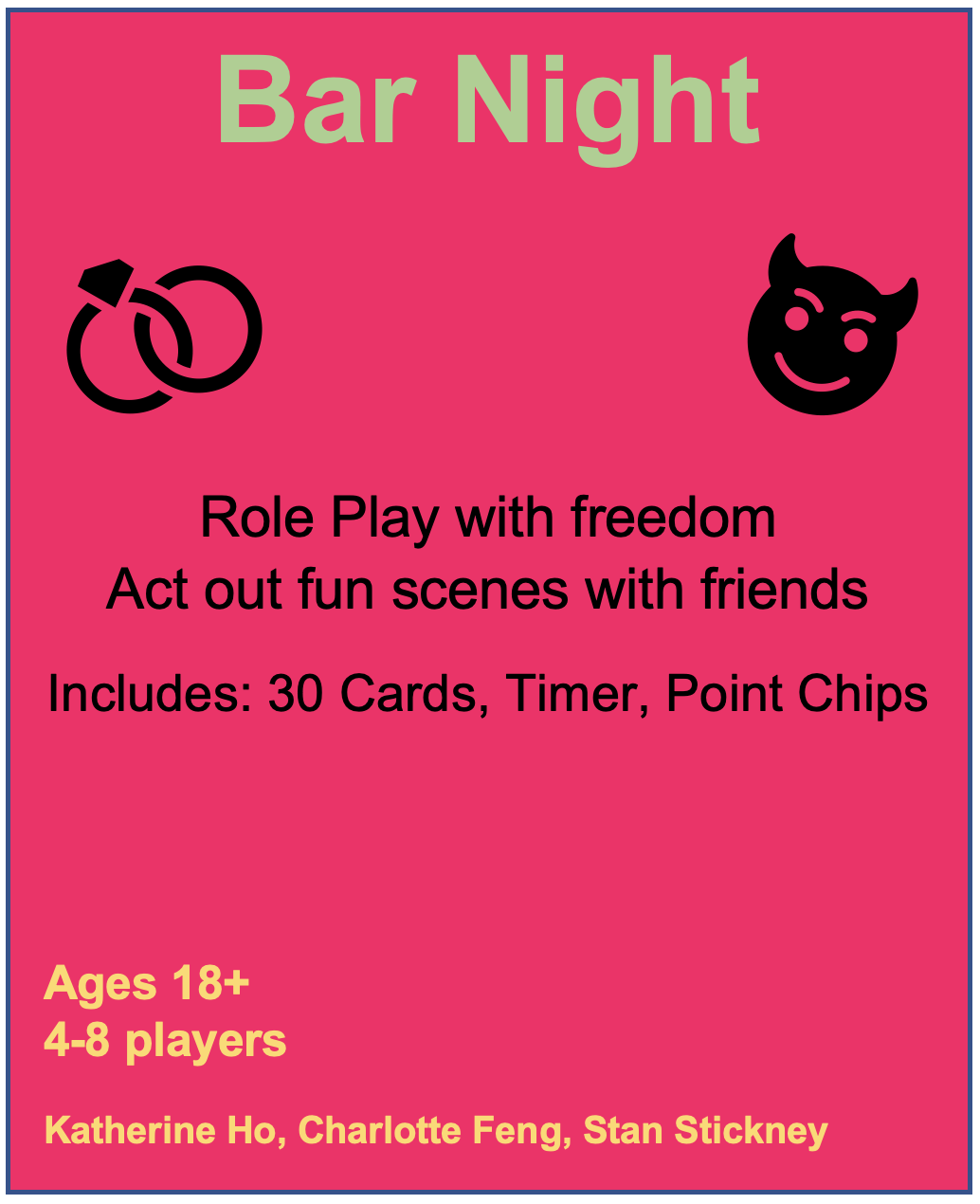Artist statement
In designing a party game, we want to bring people together in energizing, new ways. We are interested in these binding questions: How do we get acquaintances to break out of the barriers from becoming close friends? How can we create strings to pull people closer together? And how can we do so in ways that don’t rely on disclosure, but rather in ways that are fun and uplifting? We realize that role-play is an incredibly powerful agent. Role-play is a collaborative, vulnerable, and fun process. Since role-play is an inherently vulnerable process that people ages 18+ might not fully commit to, we want to cloak the role-play with objectives that spark physical and emotional intimacy in a way that is fun.
“You Are at a Bar” is a game where people are imaginatively at a bar. People are given objectives such as “You want somebody to hold your hand for 10 seconds” or “You want two free drinks” and are paired off, and, without knowing each other’s objectives, try to help each other accomplish each other’s objectives to earn points. Observers are given points if they can accurately guess the objectives correctly. Overall, through cloaking the vulnerability of role-play through the fun of trying to achieve an objective, and through cloaking the vulnerability of certain objectives, like holding somebody’s hand, through role-play, we create a balance where people, through a slant, are given protection as they take risks, open up, and energetically connect with others.
Concept map
Initial Decisions about formal elements and values
When making initial decisions about the game, we knew the most important component to us was creating a game shape that maximized fellowship. According to Daniel Cook’s explanation of how games help people build friendships, proximity and reciprocity help people become more intimate. In the game, players need to physically interact with each other, which increases proximity. We encourage players to help each other in the game, they build trust and thus build fellowships. In order to maximize fellowship in the spirit of a game people would be energized to play, we made several initial decisions on the formal elements.
First, for resources, we envisioned having both “Situation Cards” and “Character Cards”. “Situation Cards” would include both a location and an action. For instance: “You are at a bar and are flirting” or “You are at a beach and one person drowns and is saved by the other person. Afterwards, you share how much you mean to each other.” “Character Cards” would include the attributes and/or profession of the character somebody would play. For instance: “A creative writing professor who feels lonely” or “A banker who just lost a million dollars through bitcoin”. We thought about having both kinds of cards to add dynamism in the game.
Second, for rules and procedures, we envisioned that people would be given both character cards and situation cards and would be asked to act their cards out in pairs in a two minute time frame that they must use up. Other players would watch and vote for the pair of players that “Best Acted” their situation with the “Most Dynamism”. Teams that won the majority vote would earn a point. We decided on this scoring system because we wanted to encourage people to commit to their role-playing so that they could connect more deeply while doing so.
Another initial decision we made, on the players side, was that the game would at least have a player vs player component. If we paired people up for the role-play, we knew we wanted to rotate the teams so that people could work with a variety of people. Therefore, the scoring system would have to be based on the individual.
Finally, on the boundary side, we knew we didn’t want to have a real-life and role-play boundary. For instance, if the card was “You share your deepest, darkest secret”, you could share your actual darkest secret or you could make one up. In this way, ironically, the magic circle in our game could be preserved.
Testing and Iteration History
Playtest 1
Questions that we wanted to test with this prototype:
1. Will people really commit to acting and embodying these characters / situations? What happens if people are shy or don’t feel comfortable?
2. What characters or situations will be best for pushing individual growth boundaries while doing so in a safe, supported and trusted environment?
3. What superlatives should we use for the scoring system to encapsulate the experience we want people to have? Can we do better than “Best Acted” and “Most Exciting to Watch”?
We wanted to observe player interactions and test proof of concept. Katherine explained the general rules of the game and handed out three pieces of paper to each team. One piece of paper was player specific and not to be shown to their teammate. This card provided a one sentence bio about the persona the person was to take on and an action statement. Player 1 card read “Lonely trapper, asking person on date”. Player 2 card read, “Insecure and recently divorced, not open to exploring new relationships”. Both Player 1 and Player 2 shared a common scene card, which described the location and general environment of where the interaction was taking place. The scene had to continue until the 2 minute timer went off. Player 1 shared that he would have liked more discretion/ choice in selecting his bio card. He felt somewhat uncomfortable with the scenario. Player 2 expressed concerns acting out her role. She candidly shared that in game selection, she would not play this game. The acting and role playing was outside her comfort zone. Both players were very excited to learn and share their respective roles with their partner, after the time had expired. The other team was interested in Player 1 and Player 2 roles but not nearly as much as the actors themselves.
The next team consisting of Player 3 and Player 4 had a hoot of time. Player 3 bio read “Chef looking to plug her appliances in an outlet, requires help doing so”. Player 4 bio read, “wilderness explorer who has a secret waiting to be discovered”. The scene took place in a forest where Player 3 and Player 4 were on psychedelic drugs in a forest and were required to complement each other. Although both Player 3 and Player 4 enjoyed their scene, neither conveyed their intent to the other in allotted time. At the stage of our game development, we were not entirely sure if we should focus on the dynamic interaction or exploring an interactive guessing component. Based on player feedback, it seemed like the players enjoyed the dynamic role playing and wanted us to explore this component in greater detail.
Some feedback we got from our section leader Eugene was to have different levels of difficulty of characters and different categories of situations so that people can decide whether to include romantic situations if they are so inclined.
Playtest 2
Questions that we want to test with this prototype:
- Do we want to have shorter scenes? Should we have shorter card biographies? Rather than a sentence a word or two.
- What if, instead of focusing on the dynamic component of the interaction, we focused on the pursuit of achieving a goal/ in the interaction.
- What would it be like, if we added a guessing component to the game?
Players responded well to the more simplistic scenarios and character bios. Players enjoyed the universality of common easy-to-act-out roles and situations. There seemed to be a more intuitive and engaging dynamic between players. Player 1’s card read: “get a compliment”. Player 2’s card read: “get a phone number”. The shared scene took place in a heavily wooded forest.
Both players thoroughly enjoyed their interaction and felt a greater connection with their partners. This feedback was exciting to hear, particularly because the intent of the game is to foster a greater relationship between scene partners. Other feedback was equally valuable if not more, because of its instructive and insightful nature. Because the tasks were so small, they could be achieved very quickly and easily–far quicker than the allotted time. The simplistic and easy tasks took some of the struggle and challenge away from the interaction. Player 1 was complimented in the very beginning of the game, hence her task was completed. Player 2, after the interaction was over, could not guess her card action that she needed him to complete. Conversely, player 1 had a great deal of fun trying to get player 2 to give him her number. He first complimented her, and rationalized that because of the forest and not knowing where they were, they should have each other’s contact information in case they got separated. Player 1 was able to guess player 2’s objective on her first try. Player two described the let down he experienced once he achieved his task. Even though there was remaining time to act out their respective parts, he stopped role-playing. With this feedback in mind, we are exploring that fine line between guesses that are intuitive but also challenging. Both players commented that they relished the guessing component of the game. The insights above helped shape subsequent playtests.
Playtest 3
Questions that we wanted to test with this prototype:
1. Will players be more engaged if they need to guess what characters and situations to win?
2. How can we help players be more creative and free in their acting?
3. What should the goal of the game be to encourage dynamism among players?
To explore how different rules influence the dynamism among players, we tested two versions of our game with our classmates.
The first version is similar to the initial version, incorporating different levels of difficulties of characters and separating romantic and unromantic situations.
Video clip of an acting snippet: https://youtu.be/j2XvVQMVyQY
The second version was a brand new idea. Players don’t have characters or situations assigned to them anymore. Instead, each of them gets an objective to accomplish and they have all freedom to act out anything to get their objective accomplished.
Players told us they preferred the second version because it allowed them to express more creativity. They didn’t want to be restricted by the characters and situations.
Playtest 4
Questions that we wanted to test with this prototype:
1. Would the audience be engaged when other players are acting if they need to guess and judge the acting players’ objectives?
2. Do the guessing component and the achieving-an-objective component go hand-in-hand, or does the combination of the two introduce dynamics that don’t contribute meaningful to the objective of our game?
For this iteration, we decided to go with having players have objectives instead of characters and situations. In the last iteration, the audience had nothing to do when other players were acting. We want to engage the audience so we added a rule that the audience will gain points if they guess the objectives of the other players correctly. The players loved playing the game and had a good time. The players appreciated the cooperative part of the game when they helped each other achieve their objectives. They also liked the tension between wanting to get the objective but not having the task be too obvious or easy to attain. What players found confusing was the scoring part. In this playtest, each player will receive 0.5 point if they guess the objectives correctly. Players didn’t want to calculate the decimals. Therefore, we changed our scoring system from playing with numbers to using point chips to make scoring easier.
Players also suggested that at the beginning of playing, they didn’t know how to act and how to accomplish their objectives, and they learned as they played. A player suggested we provide some examples of acting or guidelines. However, we wanted to leave the interpretation of how to achieve the objectives up to the players’ decisions. We want to encourage player choice and player flexibility. It might restrict the players’ creativity if we provided examples in the first place because that anchors their mindset. Moreover, the players came up with many creative acts without any examples provided by the designers. As a result, we decided not to provide acting examples at the beginning of the game.

Video: https://youtu.be/f3rxa0tfCM4
Iterations of Game Art
A black canvas with white letters provides a distinct visual contrast. Certain words have a larger font or are capitalized with the hope that a potential consumer can have an understanding of the game at a glance. It is our assumption that the material will, generally speaking, be read from the top down. An alternative color choice was pink. It was selected in the hopes that it conveyed a form of intimacy or possible romance as an allure and an association with the game. A challenge with pink, as a background, is finding the appropriate contrast that makes it as easy as possible to read the key elements of the box at a passing look. We finally decided to go with pink and increase the contrast and saturation of the colors.
Our team resonated with Arial as a font, primarily because it is easy to read. We want the visual cognitive understanding to be as seamless as possible. Because of the readability factor, cards and directions use Ariel font as well.
Here is our final box design:


After our fruitful iterations,
here we present the final version of our game.
Feel free to print and play!
Materials: Objective Cards, Whiteboards, Point chips
Players: 4-8 players
Set-up: All players sit in a circle. Shuffle the Objective Cards. Put them in the center.
Procedure & Rule:
To play one round of the game, select the youngest player. This player will go first. Then, the game will rotate counterclockwise to select the next player who hasn’t yet gone for the round.
When it is your turn, pick a player that hasn’t yet gone. You also must try to choose somebody who you haven’t partnered with. This player will be your temporary teammate. Each of you will pick an Objective Card from the top of the deck. Keep your Objective Card hidden from your partner and everybody else.
Set a timer for 1.5 minutes. Act out a scene that takes place at a bar with your partner. No discussion or preparation can be done ahead of time. Your goal is to accomplish your objective with your partner. It is important to note that you cannot explicitly say your objective. For example, if your objective is to elicit a hug from your partner, you cannot explicitly ask for a hug. Feel free to be creative in how you accomplish your objective.
After the 1.5 minutes are over, every other player not in the scene writes a guess of both player’s objectives. After everybody is done writing down their guesses, Objective Cards are revealed. One Point Chip is given to each player who guessed both objectives correctly.
Additionally, if both players achieved their objectives, they each get two Point Chips. If one player achieved their objective, both players get one Point Chip.
Now, pick the player who is next counterclockwise who has not yet gone to go next. Do this until everybody has gone once. This marks the end of one round.
Feel free to do as many rounds as you like!
The person with the most amount of Point Chips at the end wins!


